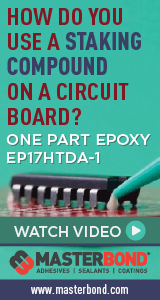|

|
|
| Ask the Experts | |||||||
|
|||||||
|
March 26, 2014 - Updated March 17, 2014 - Originally Posted Wave Solder Pot Alloy Adjustment FormulaTest reports indicate we have a tin level of 62.04% and a lead value of 37.96% in our 63/37 leaded wave solder pot. The solder pot capacity is 300KG. How many KG of pure tin should we add to the wave solder pot to restore the alloy to 63/37? Is there a formula to follow? M.R. |
|||||||
| Expert Panel Responses | |||||||
|
Theformula for adding pure tin to restore the alloy to 63/37 is: W(Sn)= (0.63-0.624)*W(ap)/0.37 W(Sn):Weight of tin need to be added; W(ap): Weight of alloy in the pot. Forexample: If you have 280 kg alloy in the pot now, the pure tin added would be: W(Sn) =(0.63-0.624)*280/0.37 = 4.54 kg
Director New Product Development Metallic Resources, Inc David Bao has more than fifteen years of experience in developing new solder paste, wave soldering fluxes and other SMT consumables. He currently serves as the Director of New Product Development at Metallic Resources Inc. He received a Ph.D. in Chemistry at Oklahoma State University.
I'llassume that you have room in the pot to make a small addition without firstremoving some. We will be adding pure tin, so the total amount of lead in thepot will remain the same. We know that after the addition, we want the percentlead to be 37.0%. So we can calculate directly the total mass of solderrequired to meet the goal:(37.96%/37.0%)*300kg = 307.7838kg Thedifference between the starting mass (300kg) and ending mass (307.7838kg) isthe required tin addition, in this case approx. 7.8kg. It's normal for the percentage of tin to drop over time because tin willbe lost at a higher rate in dross than lead. So we will occasionally have toadd some pure tin. You can minimize corrections by adding some pure tinperiodically. Track how much pure tin you need to add in total over a longperiod (say, six months) to maintain the proper tin-lead ratio, then determinehow much would need to be added per week. Institute a weekly addition of alittle less than this amount, and track again. Optimize as necessary.
Process Engineer Astronautics Fritz's career in electronics manufacturing has included diverse engineering roles including PWB fabrication, thick film print & fire, SMT and wave/selective solder process engineering, and electronics materials development and marketing. Fritz's educational background is in mechanical engineering with an emphasis on materials science. Design of Experiments (DoE) techniques have been an area of independent study. Fritz has published over a dozen papers at various industry conferences.
|
|||||||
| Submit A Comment | |||||||
|
Comments are reviewed prior to posting. You must include your full name to have your comments posted. We will not post your email address. |
|
Free Newsletter Subscription
Circuitnet is built for professionals who bear the responsibility of looking ahead, imagining the future, and preparing for it. Insert Your Email Address |
|

|




